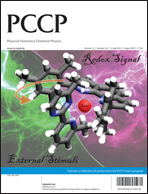Giant magnetoresistance in non-magnetic phosphoric acid doped polyaniline silicon nanocomposites with higher magnetic field sensing sensitivity†
Abstract
Phosphoric acid doped conductive polyaniline (PANI) polymer nanocomposites (PNCs) reinforced with silicon nanopowders have been successfully synthesized using a facile surface initiated polymerization (SIP) method. The chemical structures of the nanocomposites are characterized using Fourier transform infrared (FT-IR) spectroscopy. The enhanced thermal stability of the silicon–PANI PNCs compared with pure PANI is obtained using thermogravimetric analysis (TGA). The obtained optical band gap of the PNCs using Ultraviolet–visible diffuse reflectance spectroscopy (UV-vis DRS) decreases with increasing silicon loading. The dielectric properties of the PNCs are strongly related to the silicon loading level. Temperature dependent resistivity analysis reveals a quasi 3-D variable range hopping (VRH) electrical conduction mechanism for the synthesized PNCs. Room temperature giant magnetoresistance (GMR) is observed in the synthesized non-magnetic nanocomposites and analyzed using the wave-function shrinkage model.


 Please wait while we load your content...
Please wait while we load your content...